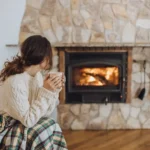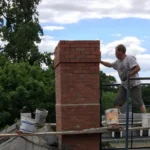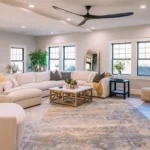When considering the comfort and convenience of a gas fireplace, safety must always come first. As gas fireplace and inserts experts in Portland, OR, the team at Portland Fireplace and Chimney has seen firsthand how proper installation, maintenance, and everyday awareness can make all the difference. Whether you’re a first-time buyer or a seasoned homeowner, understanding the essentials of gas fireplace safety is crucial, no matter where you live.
Installation and Maintenance Essentials
Professional Installation
Gas fireplace installation is not a DIY project. Working with gas lines or propane tanks requires professional expertise and proper licensing. When installing a new gas fireplace or converting a wood-burning fireplace to gas, always hire a licensed contractor. Licensing requirements vary by region, so verify that your contractor has the appropriate credentials for your area.
Before installation begins, check your local building codes for any restrictions on fireplace placement. Your contractor should obtain all necessary permits before installing gas lines or propane tanks.
Annual Professional Inspections
Schedule yearly maintenance with a qualified technician to ensure your gas fireplace operates safely and efficiently. This inspection should ideally take place about a week before you plan to start using your fireplace for the season. A professional will:
- Check gas lines for leaks or damage
- Clean the burner and control compartment
- Inspect for condensation issues
- Ensure proper ventilation
Chimney and Vent Maintenance
While gas fireplaces produce less buildup than wood-burning ones, they still require periodic cleaning of the venting system. Combustion particulates can accumulate over time, potentially causing drafting obstructions that could lead to carbon monoxide entering your home. After your first professional cleaning, your technician can recommend an appropriate maintenance schedule based on your usage patterns.
Daily Safety Practices
Carbon Monoxide Protection
Carbon monoxide (CO) is an odorless, colorless gas that can be deadly. Install carbon monoxide detectors on every floor of your home, particularly near all fuel-burning appliances, including your gas fireplace. Replace the batteries twice yearly to ensure proper functioning.
For added safety, consider a direct-vented model when purchasing a gas fireplace. These systems have sealed combustion that draws air from outside while expelling 100% of combustion exhaust outdoors, protecting your indoor air quality.
Safe Clearance Zones
Create and maintain proper clearance around your gas fireplace:
- Keep furniture, curtains, newspapers, blankets, and other flammable materials at least 3 feet away from the fireplace
- Respect the manufacturer’s specified clearance zone (typically 6 inches) around the firebox
- Never place decorative items within this safety zone
Protective Barriers
Starting in 2015, all vented gas fireplaces must have safety screens over the glass, which can get as hot as 500°F while in use. These screens create a barrier that helps prevent accidental contact with the hot surface. Remember that even with screens in place, the surrounding surfaces retain heat and should not be touched during use or for at least 30 minutes after turning off the fireplace.
For homes with young children or pets, consider installing additional safety measures:
- Use child-proof switches or safety covers to prevent accidental ignition
- Never leave children or pets unattended near an operating fireplace
- Consider installing removable safety screens for additional protection
Operating Guidelines
Proper Startup and Operation
Always read and follow the manufacturer’s safety instructions for your specific model. Before operating your gas fireplace for the first time, ensure it has been professionally inspected.
If your fireplace is installed during home construction or renovation, wait until the area is thoroughly cleaned before operation. Drywall dust and other construction debris can damage fans, motors, and burners.
If your pilot light or flame goes out, wait at least five minutes (or as specified in your owner’s manual) before attempting to relight. This allows time for gas to clear from the fireplace, which is particularly important with direct-vent models.
Ventilation Requirements
For vented fireplaces, always keep the damper fully open during operation to allow carbon monoxide to escape outdoors. Some codes require that the damper be permanently fixed so it cannot be completely closed, ensuring at least a quarter-inch opening even when in the “closed” position.
If you have a vent-free gas fireplace, be aware that these units deplete oxygen in your home. When using the fireplace for more than 30 minutes, keep a window in the vicinity slightly open to ensure adequate air circulation.
Emergency Preparedness
Recognizing Warning Signs
Be alert for unusual odors or flame patterns, which often indicate that your fireplace is not operating properly. If you notice anything unusual, contact a professional for servicing.
If you smell gas, take immediate action:
- Do not attempt to light any appliance
- Call 911
- Leave your home immediately
Regular Detector Testing
Test your carbon monoxide and smoke detectors monthly to ensure they’re functioning properly. Even with safety features like oxygen-depletion sensors that automatically shut off the gas if oxygen levels drop too low, having working detectors provides an essential backup safety system.
Conclusion
Gas fireplaces offer convenience, efficiency, and beauty to any home. By following these safety guidelines, you can enjoy the warmth and ambiance of your gas fireplace with confidence. Remember that professional installation, regular maintenance, and daily safety practices are all essential components of responsible gas fireplace ownership.
Taking the time to understand and implement these safety measures will help ensure that your gas fireplace remains a source of comfort rather than concern for years to come.
Read Also – Signs Your Chimney Needs Immediate Repair







